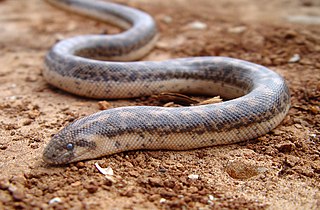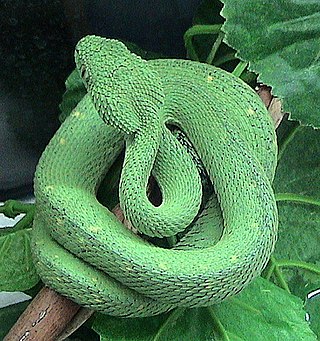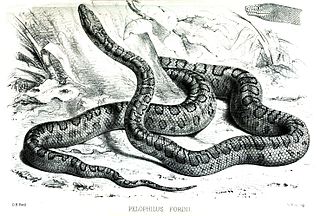
Morelia is a genus of large snakes in the family Pythonidae found in Indonesia, New Guinea, and throughout Australia. Currently, up to eight species are recognized.

The Leptotyphlopidae are a family of snakes found in North America, South America, Africa and Asia. All are fossorial and adapted to burrowing, feeding on ants and termites. Two subfamilies are recognized.

The spotted python, eastern small-blotched python, or eastern Children's python is a python species found in northern Australia and New Guinea. It is a popular pet among Australian reptile enthusiasts and other reptile enthusiasts abroad due to its small size and even temperament. No subspecies were originally recognized. However, two subspecies were recognized as of 2020; A. m. maculosa and A. m. peninsularis.

Eryx is a genus of nonvenomous snakes, commonly known as Old World sand boas, in the subfamily Erycinae of the family Boidae. Species of the genus are found in southeastern Europe, northern Africa, the Middle East, and southwestern Asia. Thirteen species are recognized as being valid.

Apodora papuana is a species of python, commonly known as the Papuan python, Irian python or Papuan olive python. It is found in New Guinea. It is the only species in the genus Apodora. No subspecies are currently recognized.

Atheris chlorechis is a viper species found only in the forests of West Africa. No subspecies are currently recognized. It is the type species of its genus. It is venomous. Atheris chlorechis venom can lead to major systemic envenoming, shock, blood loss due to coagulopathy, and renal failure. There is no antivenom.

Bitis rhinoceros is a viper species endemic to West Africa. Like all vipers, it is venomous. It can be easily distinguished from the closely related species B. gabonica by the presence of two large nasal "horns".
Echis leucogaster, also known as the white-bellied carpet viper or the Roman's saw-scaled viper, is a viper species endemic to West and Northwest Africa. Its scientific name derives from its white (leuco-), unmarked belly (gaster). like all other vipers, it is venomous. No subspecies are currently recognized.

Echis pyramidum, known as the Northeast African carpet viper, Egyptian saw-scaled viper, and by other common names, is a species of viper endemic to Northeast Africa and the Arabian Peninsula. Like all other vipers, it is venomous. Three subspecies are currently recognized, including the nominate subspecies described here.

The amethystine python, also known as the scrub python or sanca permata in Indonesian, is a species of non-venomous snake in the family Pythonidae. The species is found in Indonesia and Papua New Guinea. Popular among reptile enthusiasts, and noted for its coloration and size, it is one of the largest snakes in the world, as measured either by length or weight, and is the largest native snake in Papua New Guinea. Until 2000, the larger S. kinghorni was generally considered a subspecies of S. amethistina, and this change of classification has still not been universally reflected in literature. Because of this issue, S. amethistina has often been described as the largest snake in Australia, but this is not accurate since under the current classification, this species does not occur in Australia.
Xenotyphlops grandidieri is a species of blind snake in the family Xenotyphlopidae. The species is endemic to Madagascar. There are no subspecies that are recognized as being valid.

Tropidophis feicki, also known commonly as the broad-banded dwarf boa, the broad-banded trope, and Feick's dwarf boa, is a species of non-venomous snake in the family Tropidophiidae. The species is endemic to Cuba.
Tricheilostoma broadleyi is a species of snake in the family Leptotyphlopidae. The species is endemic to Ivory Coast.
Emin Pasha's worm snake is a species of snake in the family Leptotyphlopidae. The species is native to northern East Africa.
Wilson's blind snake is a species of snake in the family Leptotyphlopidae. The species is native to Yemen.

Chilabothrus fordii, also known commonly as Ford's boa and the Haitian ground boa, is a species of snake in the family Boidae. There are three recognized subspecies.
Cross's beaked snake is a species of snake in the family Typhlopidae. The species is native to West Africa.
The St. Thomas beaked snake is a species of snake in the family Typhlopidae. The species is native to the Gulf of Guinea off the western coast of Central Africa.
Letheobia graueri, also known commonly as the Lake Tanganyika gracile blind snake, Grauer's gracile blind snake, Sternfeld's beaked snake, and Grauer's blind snake, is a species of snake in the family Typhlopidae. The species is endemic to central and eastern Africa.
Madatyphlops domerguei is a species of snake in the family Typhlopidae. The species is endemic to Madagascar.











